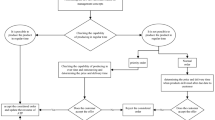Abstract
This paper compares the performance of different component allocation rules in MTS (make-to-stock) assembly systems. The component allocation problem has to be solved if actual component stocks do not cover the deviations between the secondary demand forecast and the actual component demand. This problem has high relevance for practice and is routinely solved in ERP (enterprise resource planning) systems. The available algorithms for solving this problem often apply the FCFS (first-come-first-served) rule. However, it is not known how FCFS performs compared to other rules. This paper provides new insights into this. We consider an alternative assumption on inventory reservation (FRFS: this with different prioritization rules, which are applied if orders for multiple finished products are in a backlog or occur in the same period. We show that the dominance of FRFS over FCFS in a well-researched ATO (assemble-to-order) setting does not extend to MTS systems. Our numerical results suggest that choosing a proper allocation rule can offer significant benefits. The most effective rule is FRFS with the minimization of expected finished item backorder costs. This rule can realize average savings in inventory holding and backorder costs of 8.2% compared to standard FCFS, where the earliest created orders have the highest priority. The savings increase markedly with tight capacities; the effects of lot sizes are minor.

Similar content being viewed by others
Data Availability Statement
The datasets generated during and/or analyzed during the current study are available from the corresponding author on reasonable request.
References
Hadley HG, Within TM (1963) Analysis of Inventory Systems. Prentice Hall, Englewood Cliffs NJ
Lu Y, Song JS, Zhao Y (2010) No-holdback allocation rules for continuous-time assemble-to-order systems. Oper Res 58(3):691–705
Kapuscinski R, Zhang R, Carbonneau P, Moore R, Reeves B (2004) Inventory decisions in Dell’s supply chain. Interfaces 34(3):191–205
Xu P, Allgor R, Graves S (2009) Benefits of reevaluating real-time order fulfillment decisions. Manu Serv Oper Manag 11(2):340–355
Graves SC, Willems SP (2003) Supply chain design: Safety stock placement and supply chain configuration. In: Supply Chain Management: Design, Coordination and Operation, vol. 11 of Handbooks in Operations Research and Management Science. Elsevier, Netherland, pp 95–132
de Kok TG, Fransoo JC (2003) Planning supply chain operations: Definition and comparison of planning concepts. In: Supply Chain Management: Design, Coordination and Operation, vol. 11 of Handbooks in Operations Research and Management Science. Elsevier, Netherlands, pp 597–675
Ettl M, Feigin GE, Lin GY, Yao DD (2000) A supply network model with base-stock control and service requirements. Oper Res 48(2):216–237
Albrecht M (2014) Determining near optimal base-stock levels in two-stage general inventory systems. Euro J Oper Res 232(2):342–349
Benbitour M, Sahin E, Dallery Y (2018) The use of rush deliveries in periodic review assemble-to-order systems. Int J Prod Res 57(11):1–20
de Kok TG, Visschers JW (1999) Analysis of assembly systems with service level constraints. Int J Prod Eco 59(1–3):313–326
Song JS, Zhao Y (2009) The value of component commonality in a dynamic inventory system with lead times. Manu Serv Oper Manag 11(3):493–508
Enders P, Adan I, Scheller-Wolf A, van Houtum G-J (2014) Inventory rationing for a system with heterogeneous customer classes. Flex Serv Manu J 26(3):344–386
Kilger C, Meyr H (2015) Demand Fulfilment and ATP. In: Stadtler H, Kilger C, Meyr H (eds) Supply Chain Management and Advanced Planning. Springer, Berlin et al
Quante R, Meyr H, Fleischmann M (2009) Revenue management and demand fulfillment: Matching applications, models, and software. OR Spectrum 31(1):229–256
Vogel S, Meyr H (2015) Decentral allocation planning in multi-stage customer hierarchies. Euro J Oper Res 246(2):462–470
Kloos K, Pibernik R (2020) Allocation planning under service-level contracts. Euro J Oper Res 280(1):203–218
Benjaafar S, ElHafsi M, Lee C-Y, Zhou W (2011) Technical note – optimal control of an assembly system with multiple stages and multiple demand classes. Oper Res 59(2):522–529
Nadar E, Akan M, Scheller-Wolf A (2014) Technical note – optimal structural results for assemble-to-order generalized M-systems. Oper Res 62(3):571–579
ElHafsi M, Fang J, Hamouda E (2020) A novel decomposition-based method for solving general-product structure assemble-to-order systems. Euro J Oper Res 286(1):233–249
Dogru MK, Reiman MI, Wang Q (2010) A stochastic programming based inventory policy for assemble-to-order systems with application to the W model. Oper Res 58(4):849–864
van Jaarsveld W, Scheller-Wolf A (2015) Optimization of industrial-scale assemble-to-order systems. Info J Comp 27(3):544–560
Reiman MI, Wang Q (2015) Asymptotically optimal inventory control for assemble-to-order systems with identical lead times. Oper Res 63(3):716–732
Albrecht M (2017) Optimization of safety stocks in models with an order service level objective or constraint. Euro J Oper Res 263(3):900–909
Karaarslan G, Atan Z, de Kok T, Kiesmller G (2018) Optimal and heuristic policies for assemble-to-order systems with different review periods. Euro J Oper Res 271(1):80–96
Deza A, Huang K, Liang H, Wang X (2020) On inventory allocation for periodic review assemble-to-order systems. Disc Appl Math 275:29–41
DeValve L, Pekeč S, Wei Y (2020) A primal-dual approach to analyzing ATO systems. Manag Sci. Forthcoming
Atan Z, Ahmadi T, Stegehuis C, de Kok T, Adan I (2017) Assemble-to-order systems: A review. Euro J Oper Res 261(3):866–879
Silver EA, Pyke DF, Thomas DJ (2016) Inventory and Production Management in Supply Chains. CRC Press, Boca Raton
Zipkin PH (2000) Foundations of inventory management. McGraw-Hill, Boston
Karmarkar US (1981) Equalization of runout times. Oper Res 29(4):757–762
de Kok TG, Visschers JWCH (1999) Analysis of assembly systems with service level constraints. Int J Prod Econ 59(1–3):313–326
Author information
Authors and Affiliations
Corresponding author
Ethics declarations
Financial and Ethical Disclosures
This study was not funded. The author declares that there is no conflict of interest.
Additional information
Publisher’s Note
Springer Nature remains neutral with regard to jurisdictional claims in published maps and institutional affiliations.
Rights and permissions
About this article
Cite this article
Albrecht , M. Component Allocation in Make-to-stock Assembly Systems. SN Oper. Res. Forum 2, 27 (2021). https://doi.org/10.1007/s43069-021-00067-y
Received:
Accepted:
Published:
DOI: https://doi.org/10.1007/s43069-021-00067-y




